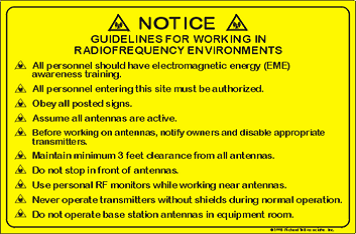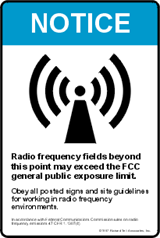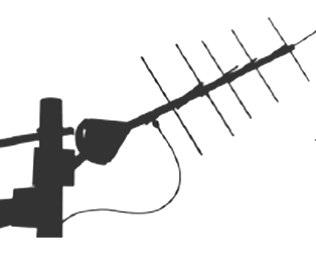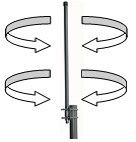
An RF Awareness Guide for Personnel Working Near Radiofrequency Transmitting Antennas at Rooftop Locations
Introduction
This RF Awareness Guide is intended for those Georgia Tech (GT) employees that access rooftop locations containing radiofrequency (RF) emitting antennae.
FCC Exposure Limits
The Federal Communications Commission (FCC) has established safety guidelines relating to RF transmitter sites. The FCC developed limits for human exposure, known as Maximum Permissible Exposure (MPE) limits, in consultation with numerous other federal agencies. The standards were developed by expert scientists and engineers after extensive reviews of scientific literature related to RF biological effects. The FCC explains that its standards incorporate prudent margins of safety.
The human exposure limits are provided for two groups of potentially exposed people.
- Occupational - People are "exposed as a consequence of their employment" and are "fully aware of the potential for exposure and can exercise control over their exposure".
- General Population - Any people that "may not be made fully aware of the potential for exposure or cannot exercise control over their exposure". This group does not receive RF Safety & Awareness Training.
Exposure Controls
Portions of any transmitter site may have high power densities that could cause exposures in excess of the FCC Occupational or General Population guidelines.
The companies that operate the antennae are required by law to implement the following:
- Restrict access
- Post notification signs on every access point to increase awareness of the potential for exposure BEFORE one enters an area with antennae
- Place additional notification signs and visual indicators in an area with antennae (beyond an access point) where RF exposure levels may start to exceed the FCC's limits
Typical Notification Signage

(Notice) RF Guidelines
Informs people of the basic safety guidelines for working in an RF environment

Information
Provides relevant contact information for any questions or requests

(Blue) Notice
Indicates that, beyond the sign, RF exposure levels may exceed the General Population MPE limit but will remain below the Occupational MPE limit

(Yellow) Caution
Indicates that, beyond the sign, RF exposure levels may exceed the General Population and Occupational MPE limits

(Red) Warning
Indicates that, beyond the sign, RF exposure levels may substantially exceed the General Population and Occupational MPE limits
Indicative Barriers
In addition to physical barriers such as locked doors or ladders, antenna operators may also be required to place indicative barriers as a means of visually marking an area where RF levels are expected to exceed the FCC's limits. Examples of Indicative Barrier materials are: plastic chains, buckets, reflective paint or tape, plastic cones, fiberglass fences, and poles mounted in cinderblocks.
Common Antenna Types

Yagi
Antenna that radiates energy in one direction. RF energy has a narrow beam. Walk behind or under this antenna.

Panel
Antenna that radiates energy in one direction. RF energy beam can range from narrow to very wide. Walk behind this antenna. Stay out of the general direction that antenna is pointing.

Whip
Antenna that radiates energy equally in all directions. Maintain as much distance as possible from this antenna.

Microwave
Antenna that radiates energy in one direction. RF energy has a narrow beam. Walk behind or under this antenna.
Guidelines for Working in Rooftop Radiofrequency Environments
Always follow these points when working around electromagnetic energy (EME):
- All personnel entering the site should have radiofrequency radiation awareness training.
- All personnel entering the site must be authorized.
- Obey all posted signs.
- Assume all antennas are active.
- Before working on antennas, notify owners and disable appropriate transmitters.
- Maintain minimum 3 feet clearance from all antennas.
- Do not stop in front of antennas.
What Biological Effects Can Be Caused by RF Energy?
Biological effects can result from human exposure to RF energy. Biological effects that result from heating of tissue by RF energy are often referred to as "thermal" effects. It has been known for many years that exposure to very high levels of RF radiation can be harmful due to the ability of RF energy to heat biological tissue rapidly. This is the principle by which microwave ovens cook food.
Exposure to very high RF intensities can result in heating of biological tissue and an increase in body temperature. Tissue damage in humans could occur during exposure to high RF levels because of the body's inability to cope with or dissipate the excessive heat could be generated. Two areas of the body, the eyes and the testes, are particularly vulnerable to RF heating because of the relative lack of available blood flow to dissipate the excessive heat load.
There is currently no clear connection between RF exposure and cancer development.
Other Documents with Information on RF
Human Exposure to Radio Frequency Fields: Guidelines For Cellular and PCS Sites
Summary of Biological Effects of RF Exposure taken from the Federal Communications Commission (FCC) Radio Frequency Safety Frequently Asked Questions
Contact for Questions
Georgia Tech
Office of Radiological Safety
Office: 404-894-3605
Email: ors@ors.gatech.edu